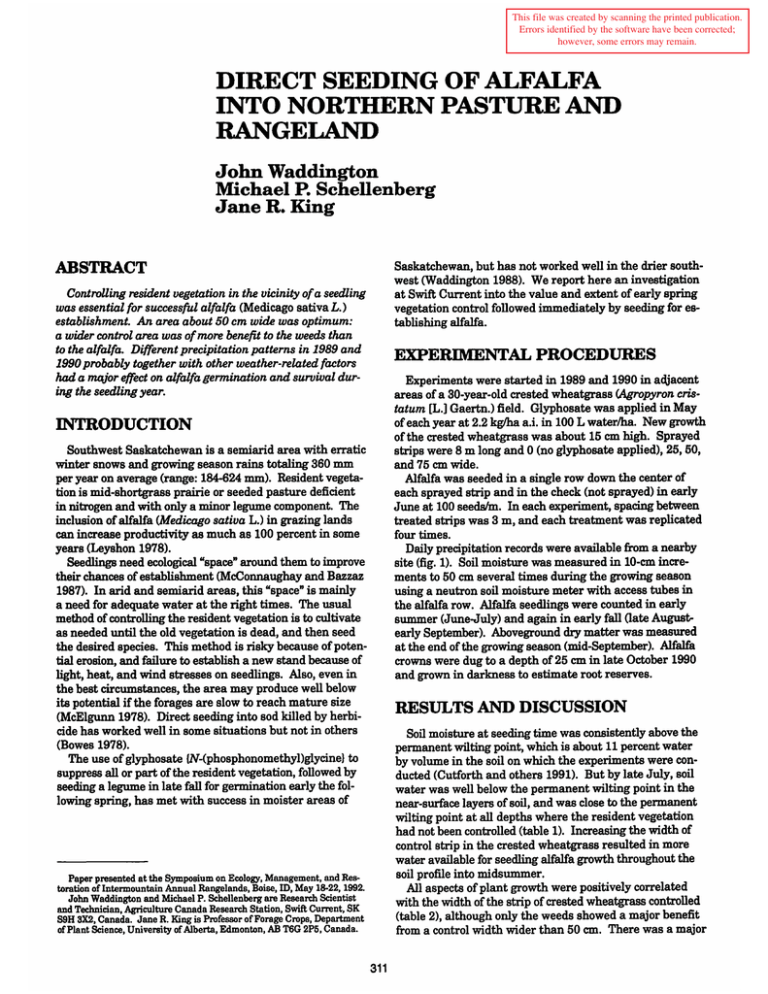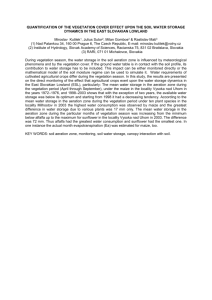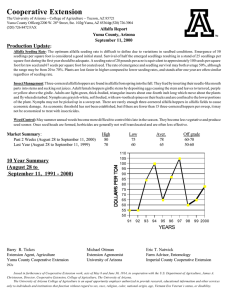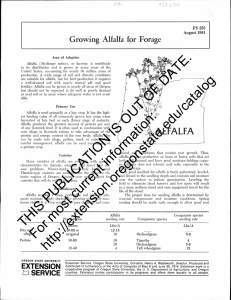DIRECT SEEDING OF ALFALFA INTO NORTHERN PASTURE AND RANGELAND John Waddington
advertisement

This file was created by scanning the printed publication.
Errors identified by the software have been corrected;
however, some errors may remain.
DIRECT SEEDING OF ALFALFA
INTO NORTHERN PASTURE AND
RANGELAND
John Waddington
Michael P. Schellenberg
JaneR.King
ABSTRACT
Saskatchewan, but has not worked well in the drier southwest (Waddington 1988). We report here an investigation
at Swift Current into the value and extent of early spring
vegetation control followed immediately by seeding for establishing alfalfa.
Controlling resident vegetation in the vicinity of a seedling
was essential for successful alfalfa (Medicago sativa L.)
establishment. An area about 50 em wide was optimum:
a wider control area was of more benefit to the weeds than
to the alfalfa. Different precipitation patterns in 1989 and
1990 probably together with other weather-related factors
had a major effect on alfalfa germination and survival during the seedling year.
EXPERDKENTALPROCEDURES
Experiments were started in 1989 and 1990 in acljacent
areas of a 30-year-old crested wheatgrass (Agropyron criBtatum [L.] Gaertn.) field. Glyphosate was applied in May
of each year at 2.2 kg/ha a.i. in 100 L water/ha. New growth
of the crested wheatgrass was about 15 em high. Sprayed
strips were 8 m long and 0 (no glyphosate applied), 25, 50,
and 75 em wide.
Alfalfa was seeded in a single row down the center of
each sprayed strip and in the check (not sprayed) in early
June at 100 seedslm. In each experiment, spacing between
treated strips was 3 m, and each treatment was replicated
four times.
Daily precipitation records were available from a nearby
site (fig. 1). Soil moisture was measured in 10-em increments to 50 em several times during the growing season
using a neutron soil moisture meter with access tubes in
the alfalfa row. Alfalfa seedlings were counted in early
summer (June-July) and again in early fall Gate Augustearly September). Aboveground dry matter was measured
at the end of the growing season (mid-September). Alfalfa
crowns were dug to a depth of 25 em in late October 1990
and grown in darkness to estimate root reserves.
INTRODUCTION
Southwest Saskatchewan is a semiarid area with erratic
winter snows and growing season rains totaling 360 mm
per year on average (range: 184-624 mm). Resident vegetation is mid-shortgrass prairie or seeded pasture deficient
in nitrogen and with only a minor legume component. The
inclusion of alfalfa (Medicago sativa L.) in grazing lands
can increase productivity as much as 100 percent in some
years (Leyshon 1978).
Seedlings need ecological "space" around them to improve
their chances of establishment (McConnaughay and Bazzaz
1987). In arid and semiarid areas, this "space" is mainly
a need for adequate water at the right times. The usual
method of controlling the resident vegetation is to cultivate
as needed until the old vegetation is dead, and then seed
the desired species. This method is risky because of potential erosion, and failure to establish a new stand because of
light, heat, and wind stresses on seedlings. Also, even in
the best circumstances, the area may produce well below
its potential if the forages are slow to reach mature size
(McElgunn 1978). Direct seeding into sod killed by herbicide has worked well in some situations but not in others
(Bowes 1978).
The use of glyphosate {N-(phosphonomethyl)glycine} to
suppress all or part of the resident vegetation, followed by
seeding a legume in late fall for germination early the following spring, has met with success in moister areas of
RESULTS AND DISCUSSION
Soil moisture at seeding time was consistently above the
permanent wilting point, which is about 11 percent water
by volume in the soil on which the experiments were conducted (Cutforth and others 1991). But by late July, soil
water was well below the permanent wilting point in the
near-surface layers of soil, and was close to the permanent
wilting point at all depths where the resident vegetation
had not been controlled (table 1). Increasing the width of
control strip in the crested wheatgrass resulted in more
water available for seedling alfalfa growth throughout the
soil profile into midsummer.
All aspects of plant growth were positively correlated
with the width of the strip of crested wheatgrass controlled
(table 2), although only the weeds showed a major benefit
from a control width wider than 50 em. There was a major
Paper presented at the Symposium on Ecology, Management, and Restoration of Intermountain Annual Rangelands, Boise, ID, May 18-22, 1992.
John Waddington and Michael P. Schellenberg are Research Scientist
and Technician, Agriculture Canada Research Station, Swift Current, SK
S9H 3X2, Canada. Jane R. King is Professor of Forage Crops, Department
of Plant Science, University of Alberta, Edmonton, AB T6G 2P5, Canada.
311
80
....-.._
E
E 60
_,_,..
c
~ 1989
-
1990
0
..,
·-..,as
·-a. 40
·-u
.
Cl)
D.
-..,as
20
0
to~~~~~~~~~~~~~~~~~~--~~~~~~-
1 2 3 411 2 3 411 2 3 411 2 3 411 2 3 4
May
June
July
Aug.
Week in Month
Sept.
Figure 1-Total weekly precipitation for May 1 to September 30 for 1989 and 1990.
Table 1-Effect of width of vegetation control area on summer moisture levels (percent) in soil beneath seedling alfalfa1
Width of vegetation control
Soli
depth
em
0
10
20
30
40
Ocm
July 29, 1989
25cm
50cm
75cm
August 14, 1990
25cm
50cm
Ocm
75cm
- - - - - - - - - - - - - - - - - - - - - - - - - - - - - - - - - Percent moisture- - - - - - - - - - - - - - - - - - - - - - - - - - - - - - 5.3
9.3
10.0
10.8
12.0
1Permanent wilting
5.6
12.3
13.8
15.2
16.3
6.1
14.1
15.4
16.2
17.3
5.0
12.6
14.2
15.3
16.4
5.9
12.8
14.5
14.3
13.6
5.6
9.7
10.8
11.4
11.8
11.6
16.3
18.2
19.0
18.3
9.5
16.6
18.0
18.9
16.9
point Is about 11 percent In this soil.
Table 2-Effect of width of vegetation control on alfalfa and weed establishment and growth characteristics
Plants
and
characteristics
Alfalfa
PopJm
D.M. (glm)
Regrowth (glplant)
Weeds
D.M. (glm)
Width of vegetation control (em)
1989
0
25
50
75
0
10
0.5
0.07
39
5.1
0.18
44
13.3
0.30
47
14.8
0.33
0
0.1
0.03
1.2
7.4
24.9
43.3
0
312
1990
25
50
75
8
1.6
0.3
13
6.2
0.7
16
10.8
0.7
0.4
1.0
6.9
difference between 1989 and 1990 in alfalfa seedling numbers and plant growth in the field. This reflects the heavy
rainfall shortly after seeding in 1989 (fig. 1), which resulted
in excellent seedling germination and establishment that
year.
The benefit did not appear in regrowth ability as measured
by growth to exhaustion in the dark (table 2). Perhaps those
seedlings that did establish in 1990 had larger root reserves
because there was less competition between alfalfa plants
than in 1989.
REFERENCES
Bowes, G. 1978. General methods of forage establishment
in western Canada. In: McElgunn, J. D., ed. Pasture systems for the cow-calf. Swift Current, SK: Agriculture
Canada Research Station: 129-134.
Cutforth, H. W.; Jefferson, P. G.; Campbell, C. A. 1991.
Lower limit of available water for three plant species
313
grown on a medium textured soil in southwestern
Saskatchewan. Canadian Journal of Soil Science.
71: 247-252.
Leyshon, A. J. 1978. Soil fertility, fertilizers, and forages.
In: McElgunn, J. D., ed. Pasture systems for the cowcalf. Swift Current, SK: Agriculture Canada Research
Station: 140-164.
McConnaughay, K D. M.; Bazzaz, F. A. 1987. The relationship between gap size and performance of several colonizing annuals. Ecology. 68: 411-416.
McElgunn, J. D. 1978. Pasture establishment and concerns.
In: McElgunn, J.D., ed. Pasture systems for the cow-calf.
Swift Current, SK: Agriculture Canada Research Station:
114-128.
Waddington, J. 1988. Renovation of pastures by direct seeding. Final Report, Saskatchewan Agricultural Research
Fund #3-84-22. 69 p. [Mimeo].




